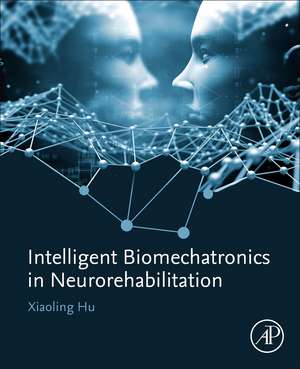Intelligent Biomechatronics in Neurorehabilitation
Autor Xiaoling Huen Limba Engleză Paperback – 21 oct 2019
As the aging population continues to grow, healthcare providers are faced with the challenge of developing long-term rehabilitation for neurological disorders, such as stroke, Alzheimer’s and Parkinson’s diseases. Intelligent biomechatronics provide a seamless interface and real-time interactions with a biological system and the external environment, making them key to automation services.
- Written by international experts in the rehabilitation and bioinstrumentation industries
- Covers the current understanding of nervous system coding mechanisms, which are the basis for biological and robotic interfaces
- Demonstrates and discusses robotic rehabilitation effectiveness and automatic evaluation
Preț: 700.34 lei
Preț vechi: 877.92 lei
-20% Nou
Puncte Express: 1051
Preț estimativ în valută:
134.01€ • 139.92$ • 110.91£
134.01€ • 139.92$ • 110.91£
Carte tipărită la comandă
Livrare economică 28 martie-11 aprilie
Preluare comenzi: 021 569.72.76
Specificații
ISBN-13: 9780128149423
ISBN-10: 0128149426
Pagini: 286
Dimensiuni: 191 x 235 mm
Greutate: 0.5 kg
Editura: ELSEVIER SCIENCE
ISBN-10: 0128149426
Pagini: 286
Dimensiuni: 191 x 235 mm
Greutate: 0.5 kg
Editura: ELSEVIER SCIENCE
Public țintă
Undergraduate and graduate biomedical engineering students, specifically in biomechatronics; biomedical engineers and researchers specializing in biomechatronicsCuprins
Part I. Neural Coding Mechanisms1. Neural Coding at Cellular Level2. Neural Coding by Electrocorticography (ECoG)3. Neural Coding by Electroencephalography (EEG)4. Neuromuscular Coding by Electromyography (EMG)
Part II. Biomechatronic Systems5. Rehabilitation Robots with Brain Computer Interface (BCI)6. Bionic Robotics for Amputees7. Voluntary Intention Driven Rehabilitation Robots for the Upper Limb8. Integration of Sensory Stimulation into Robots9. Robotic and Functional Electrical Stimulation (FES) Hybrid System
Part III. Clinical Applications and Commercialization10. Clinical Evaluations by Robots in Rehabilitation11. Clinical Trials on Rehabilitation with Voluntary Intention Driven Robots13. Automation in Neurorehabilitation: Needs Addressed by Clinicians14. Commercialization of rehabilitation robotics: Chances and Challenges15. Comparison on the Rehabilitation Effectiveness between Trials and Real Services
Part II. Biomechatronic Systems5. Rehabilitation Robots with Brain Computer Interface (BCI)6. Bionic Robotics for Amputees7. Voluntary Intention Driven Rehabilitation Robots for the Upper Limb8. Integration of Sensory Stimulation into Robots9. Robotic and Functional Electrical Stimulation (FES) Hybrid System
Part III. Clinical Applications and Commercialization10. Clinical Evaluations by Robots in Rehabilitation11. Clinical Trials on Rehabilitation with Voluntary Intention Driven Robots13. Automation in Neurorehabilitation: Needs Addressed by Clinicians14. Commercialization of rehabilitation robotics: Chances and Challenges15. Comparison on the Rehabilitation Effectiveness between Trials and Real Services

























